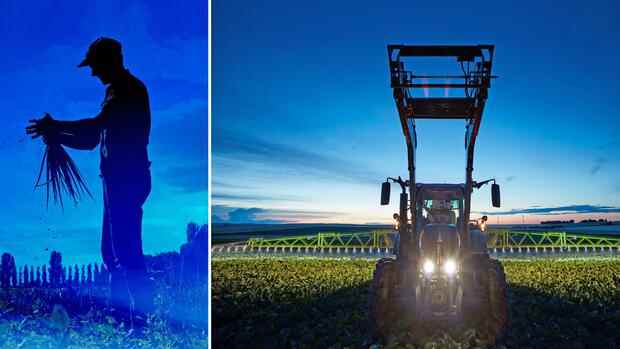Dusseldorf Because of the crushingly high price of natural gas, the first major manufacturers of fertilizers are reducing their production. The European market leader in nitrogen fertilizers, the Yara Group from Norway, wants to reduce the capacity utilization of its plants to 45 percent. The Austrian Borealis Group is also shutting down its ammonia plants. The chemical is a core component for nitrogen fertilizers, which are required in large quantities by agriculture.
At the largest German ammonia manufacturer SKW Piesteritz, production is still running normally. However, the situation is reassessed from day to day, according to the company from Wittenberge in Saxony-Anhalt. Throttling is also an option here.
This indicates a further shortage in the supply of fertilizer to agriculture. Even before the war in Ukraine, the market was practically empty and the available quantities were sold at record prices. Fertilizer is currently almost four times as expensive as it was at the beginning of last year.
The situation is getting worse for agriculture and food supply, because in the northern hemisphere the fertilizer is needed for the upcoming sowing. Agricultural experts fear losses in harvests. This is less true for Europe, but more so for large fertilizer importers such as Brazil, India and China.
Top jobs of the day
Find the best jobs now and
be notified by email.
These countries depend primarily on supplies from Russia, from where large quantities of fertilizer are exported. On Thursday, however, Moscow announced that it would temporarily suspend the export of fertilizer types. This is intended to protect local agriculture. However, there are delivery agreements with “friendly countries”.
>> Read here: Russia is threatening the West with severe counter-sanctions – and is likely to pay a high price
The high gas price had already forced European ammonia manufacturers to cut production last autumn. Natural gas accounts for up to 80 percent of the production costs because it is used both as a raw material and as an energy supplier.
At the beginning of the year, the situation had eased somewhat, but now the bottleneck is intensifying again rapidly. This is not only due to the expensive gas. Deutsche Bank analyst Virginie Boucher-Ferte expects that the Ukraine war as a whole and the sanctions that have been passed against Russia are likely to further reduce the supply of fertilizer in the coming months.
Exports from Russia are also logistically difficult
The analyst points out that Russia is the world’s largest fertilizer exporter and has contributed about 20 percent to global trade. But a large part of the exports should now be stopped. Russia alone has a market share of 40 percent for the fertilizer ammonium nitrate. There has been an export ban here for a long time.
Even if there were no government restrictions, exporting Russian fertilizer would be difficult. On the one hand, payment transactions are made more difficult by the sanctions, as several market participants report. On the other hand, exports fail due to logistical problems. The sea route across the Black Sea is severely restricted, but there is also a lack of shipping capacity in the northern ports of Russia because large shipping companies no longer call at the country.
Above all, agriculture in Brazil, where soya is grown on huge areas, is dependent on nitrogen fertilizers from Russia. The German Farmers’ Association does not yet have any current data for the supply in this country. One thing is clear: “In Germany, the war will primarily trigger rising food prices,” says Udo Hemmling, Deputy Secretary General of the association.
Because the costs for the basic fertilizer potassium chloride, as produced by the German K+S Group, are also increasing unchecked. Although potash is not extracted from natural gas, it is a mining product. Nevertheless: While a ton of the standard product MOP cost 245 dollars at the beginning of 2021, it is currently more than 900 dollars.
Initially, the US and EU sanctions against Belarus, which have been in effect since early 2022, drove up the price of potash. The country is one of the top three producers of potassium chloride. The manufacturer Belaruskali no longer supplies potash fertilizer to the West.
European agriculture is currently served primarily by the world’s fourth-largest potash producer K+S from Kassel and by the Israeli ICL. However, analyst Markus Mayer from Baader Bank fears that these two companies alone will not be able to fully meet the demand if, after Belaruspotash, Russian potash manufacturers can no longer deliver due to sanctions. This could severely affect supply in the West for a long time.
K+S boss Burkard Lohr does not share this fear. The importance of Eastern European potash producers for the EU is not that great, and he observes that there has even been a slight decline in demand for potash fertilizers in Europe. The reason is the lack of nitrogen fertilizers, which ensure the growth of the plants. If these are not available, it makes no sense for the farmers to fertilize with potassium chloride. The different types of fertilizer are used at the same time and work together.
At K+S, production continues as normal. The group is benefiting from the sharp rise in prices and wants to achieve an operating profit of between 1.6 and 1.9 billion euros this year. It would be the best result in the company’s history.
More: Wheat price breaks all records – and stirs up fears of unrest worldwide

